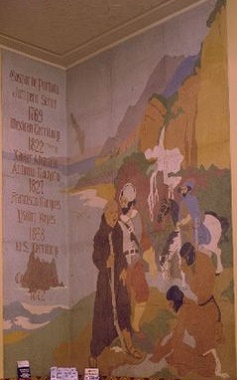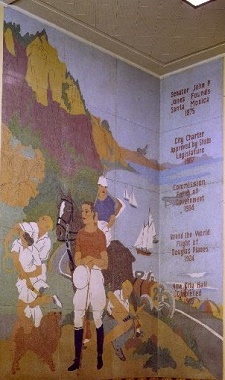|
By Jorge Casuso
February 6, 2024 -- The Ciy Council on Tuesday is expected to take initial steps to "reframe" the towering murals that have greeted visitors to City Hall since 1939 but have recently become a subject of controversy.
Advocates of removing the murals -- which depict Native Americans kneeling before Spanish conquistadors and privileged Anglos enjoying upper-class sports -- argue they are expressions of white supremacy.
  |
| City Hall murals (Courtesy City of Santa Monica) |
Supporters of the murals by renown Santa Monica artist Stanton Macdonald-Wright contend the paintings have historic and artistic merit and are being misrepresented by critics.
The key recommendations presented by the City's consultant, Meztli Projects, which are based on community input, attempt to strike a middle ground by commissioning new artworks and interpretive panels that address the criticism.
"When communities have chosen to recontextualize rather than remove public art and monuments, the efforts are often driven by a desire to avoid erasing the stains of the past," staff wrote in a report to Council.
Instead, they "use the process and new artworks to educate, with the goal of acknowledging historic inequities and committing to a more just future."
The new artworks, according to the report, "should present history from different perspectives and celebrate and reframe what is traditionally presented as 'historically significant.'
"City Hall is a center of power, and the new work needs to balance or redress the exclusions exemplified in the existing mural," as well as "address the hierarchies in the southwest panels" depicting white residents in a privileged setting.
The commissioned artwork should include "Black, Brown, Asian American, working-class people, unemployed people, and poor people who were in Santa Monica in 1939 and deal with themes of ongoing Indigenous presence."
The interpretive panels, should be difficult to miss by those entering City Hall and "ideally installed in close visual proximity " to the existing murals, according to the report.
The panels should be written "by an advisory group including an Indigenous person and other people of color" and "condemn colonization, forced religious conversion, white supremacy generally and the mural’s portrayal of First Peoples in particular."
To arrive at the recommendations in the report -- which will be presented to the Council on Tuesday -- Meztli Projects gathered community input through panel discussions, meetings, surveys and tours.
Meztli had people "engage directly with the mural images to understand not just how they interpreted the images, but also their emotional responses and attachments to the mural," according to the report.
Based on a total of 337 responses collected from February 6 to May 10 of last year, a majority "found one or both of the mural panels to be offensive, disturbing, or exclusionary," according to the report.
"Overall, these respondents felt that the mural represented the hierarchies inherent in settler colonialism and white supremacy."
A smaller group of respondents found the mural images beautiful or valuable, but said they "have significant flaws that require a response."
|